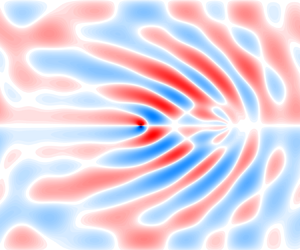Article contents
The decay of a dipolar vortex in a weakly dispersive environment
Published online by Cambridge University Press: 28 April 2021
Abstract

A simple model is presented for the evolution of a dipolar vortex propagating horizontally in a vertical-slice model of a weakly stratified inviscid atmosphere, following the model of Flierl & Haines (Phys. Fluids, vol. 6, 1994, pp. 3487–3497) for a modon on the  ${\rm beta}$-plane. The dipole is assumed to evolve to remain within the family of Lamb–Chaplygin dipoles but with varying radius and speed. The dipole loses energy and impulse through internal wave radiation. It is argued, and verified against numerical solutions of the full equations, that an appropriately defined centre vorticity for the dipole is closely conserved throughout the flow evolution. Combining conservation of centre vorticity with the requirement that the dipole energy loss balances the work done on the fluid by internal wave radiation gives a model that captures much of the observed dipole decay. Similar results are noted for a cylindrical dipole propagating along the axis of a rotating fluid when the dipole axis is perpendicular to the axis of rotation and for a spherical vortex propagating horizontally in a weakly stratified fluid. The model extends to fluids of small viscosity and so provides an estimate for the relative importance of wave drag and dissipation in dipole decay.
${\rm beta}$-plane. The dipole is assumed to evolve to remain within the family of Lamb–Chaplygin dipoles but with varying radius and speed. The dipole loses energy and impulse through internal wave radiation. It is argued, and verified against numerical solutions of the full equations, that an appropriately defined centre vorticity for the dipole is closely conserved throughout the flow evolution. Combining conservation of centre vorticity with the requirement that the dipole energy loss balances the work done on the fluid by internal wave radiation gives a model that captures much of the observed dipole decay. Similar results are noted for a cylindrical dipole propagating along the axis of a rotating fluid when the dipole axis is perpendicular to the axis of rotation and for a spherical vortex propagating horizontally in a weakly stratified fluid. The model extends to fluids of small viscosity and so provides an estimate for the relative importance of wave drag and dissipation in dipole decay.
- Type
- JFM Papers
- Information
- Copyright
- © The Author(s), 2021. Published by Cambridge University Press
References
REFERENCES
- 7
- Cited by



